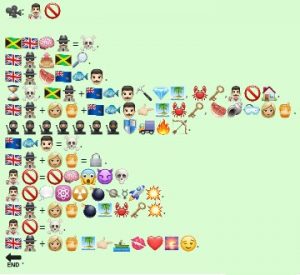
This work is one of my favourite movies and holds a special place in my heart, as my partner and I bonded over this film and its lead character during our ‘courting’ stage. And yes, it was also selected because I could imagine how to represent it in emojis more easily than many other options I had swirling in my mind. In creating this task, I started with the title; to me, it was the most logical order of things and confirmed in my mind that my selected work could be translated. ‘Translation’ best describes my process as I relied on a combination of words and ideas to dictate which emojis to use. I found https://emojikeyboard.io and https://emojipedia.org/ to be rather limiting compared to what I was used to using, so I ended up writing it as a WhatsApp message on my phone, opening WhatsApp up on my desktop and taking a screenshot of the message which I then saved as an image.
I initially found this task particularly challenging because I consider my emoji use as low. I use emojis, but I prefer text-based messages with icons used to guide emotion, context, or intention (Bolter, 2001). However, I am starting to use certain icons as substitutes for text: ![]() for “I agree with you” and
for “I agree with you” and ![]() for “OK,” “good,” or “glad to hear.” Perhaps this gravitation toward multimodal communication is an effort to make my messages more appealing or to provide a more immediate response to my reader (Bolter). I also agree with Kress (2005) that this multimodal approach of interspersing icons within text – or moving entirely to icon-based messages – is indeed beyond the mere “ability to read and write” (as cited in the course notes) and transcends language to some degree. I still feel I need to make a conscious effort to learn how to ‘speak’ with emojis, and likely by the time I feel ‘fluent’ in emoji language the meanings of some icons will have changed. This made me relate to Bolter’s (2001) comment about older technologies remediating newer ones; perhaps the continued intertwining of images and text will eventually remediate my own communication style, through my own apprehension
for “OK,” “good,” or “glad to hear.” Perhaps this gravitation toward multimodal communication is an effort to make my messages more appealing or to provide a more immediate response to my reader (Bolter). I also agree with Kress (2005) that this multimodal approach of interspersing icons within text – or moving entirely to icon-based messages – is indeed beyond the mere “ability to read and write” (as cited in the course notes) and transcends language to some degree. I still feel I need to make a conscious effort to learn how to ‘speak’ with emojis, and likely by the time I feel ‘fluent’ in emoji language the meanings of some icons will have changed. This made me relate to Bolter’s (2001) comment about older technologies remediating newer ones; perhaps the continued intertwining of images and text will eventually remediate my own communication style, through my own apprehension ![]() and enthusiasm
and enthusiasm ![]() .
.
All that said, can you guess which movie this is?
References
Bolter, J. D. (2001). Chapter 4: The breakout of the visual. In Writing space: Computers, hypertext, and the remediation of print (2nd ed.). Mahwah, N.J: Lawrence Erlbaum Associates. https://doi.org/10.4324/9781410600110
Kress, G. (2005). Gains and losses: New forms of texts, knowledge, and learning. Computers and Composition, 22 (1), 5-22. https://doi.org/10.1016/j.compcom.2004.12.004
